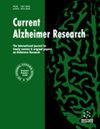Link of BIN1, CLU and IDE gene polymorphisms with the susceptibility of Alzheimer's disease: evidence from a meta-analysis.
IF 1.9
4区 医学
Q3 CLINICAL NEUROLOGY
引用次数: 0
Abstract
BACKGROUND Alzheimer's disease (AD) is the most common form of neurodegenerative disorder. The association of BIN1, CLU and IDE genetic polymorphisms with AD risk have been evaluated overtimes that produced conflicting outcomes. OBJECTIVE We performed this meta-analysis to investigate the contribution of BIN1 (rs744373 and rs7561528), CLU (rs11136000 and rs9331888), and IDE (rs1887922) polymorphisms to AD risk. METHODS From a systemic literature search up to July 15, 2021, we included 25 studies with rs744373, 16 studies with rs7561528, 37 studies with rs11136000, 16 studies with rs9331888, and 4 studies with rs1887922. To analyze the correlation, we constructed seven genetic models that used odds ratio and 95% confidence intervals. We used RevMan 5.4 for meta-analysis. RESULTS Our study suggests that BIN1 rs744373 is associated with a significantly increased risk of AD in five genetic models (OR>1). Again, CLU rs11136000 showed reduced association in all genetic models (OR<1). CLU rs9331888 revealed an increased association in two models (OR>1). The IDE rs1887922 showed significantly increased risk in four models (OR>1). From subgroup analysis, a significantly increased risk of AD was observed in Caucasians and Asians for BIN1 rs744373. Again, BIN1 rs7561528 showed a significantly enhanced risk of AD only in Caucasians. CLU rs11136000 showed significantly reduced risk in Caucasians but rs9331888 showed increased risk in the same ethnicity. CONCLUSION Our meta-analysis confirms the association of BIN1 rs744373, CLU rs9331888 and IDE rs1887922 polymorphisms with an increased risk of AD, especially in Caucasians. Again, CLU rs11136000 is associated with reduced AD risk in the overall population and Caucasians.BIN1、CLU和IDE基因多态性与阿尔茨海默病易感性的联系:来自荟萃分析的证据
背景:阿尔茨海默病(AD)是最常见的神经退行性疾病。BIN1、CLU和IDE基因多态性与AD风险的关系已被长期评估,但结果相互矛盾。目的:研究BIN1 (rs744373和rs7561528)、CLU (rs11136000和rs9331888)和IDE (rs1887922)多态性对AD风险的影响。方法通过系统文献检索,截至2021年7月15日,我们纳入了25项rs744373、16项rs7561528、37项rs11136000、16项rs9331888和4项rs1887922的研究。为了分析相关性,我们使用比值比和95%置信区间构建了7个遗传模型。我们使用RevMan 5.4进行meta分析。结果我们的研究表明,在5种遗传模型中,BIN1 rs744373与阿尔茨海默病风险显著增加相关(OR bbb1)。同样,CLU rs11136000在所有遗传模型中均显示相关性降低(OR1)。IDE rs1887922在四种模型中显示出显著增加的风险(OR>1)。从亚组分析来看,携带BIN1 rs744373的高加索人和亚洲人患AD的风险显著增加。同样,BIN1 rs7561528仅在白种人中显示AD的风险显著增加。CLU rs11136000在白种人中风险显著降低,而rs9331888在同一种族中风险增加。我们的荟萃分析证实了BIN1 rs744373、CLU rs9331888和IDE rs1887922多态性与AD风险增加的相关性,尤其是在白种人中。同样,CLU rs11136000与总体人群和白种人的AD风险降低有关。
本文章由计算机程序翻译,如有差异,请以英文原文为准。
求助全文
约1分钟内获得全文
求助全文
来源期刊

Current Alzheimer research
医学-神经科学
CiteScore
4.00
自引率
4.80%
发文量
64
审稿时长
4-8 weeks
期刊介绍:
Current Alzheimer Research publishes peer-reviewed frontier review, research, drug clinical trial studies and letter articles on all areas of Alzheimer’s disease. This multidisciplinary journal will help in understanding the neurobiology, genetics, pathogenesis, and treatment strategies of Alzheimer’s disease. The journal publishes objective reviews written by experts and leaders actively engaged in research using cellular, molecular, and animal models. The journal also covers original articles on recent research in fast emerging areas of molecular diagnostics, brain imaging, drug development and discovery, and clinical aspects of Alzheimer’s disease. Manuscripts are encouraged that relate to the synergistic mechanism of Alzheimer''s disease with other dementia and neurodegenerative disorders. Book reviews, meeting reports and letters-to-the-editor are also published. The journal is essential reading for researchers, educators and physicians with interest in age-related dementia and Alzheimer’s disease. Current Alzheimer Research provides a comprehensive ''bird''s-eye view'' of the current state of Alzheimer''s research for neuroscientists, clinicians, health science planners, granting, caregivers and families of this devastating disease.
 求助内容:
求助内容: 应助结果提醒方式:
应助结果提醒方式:


